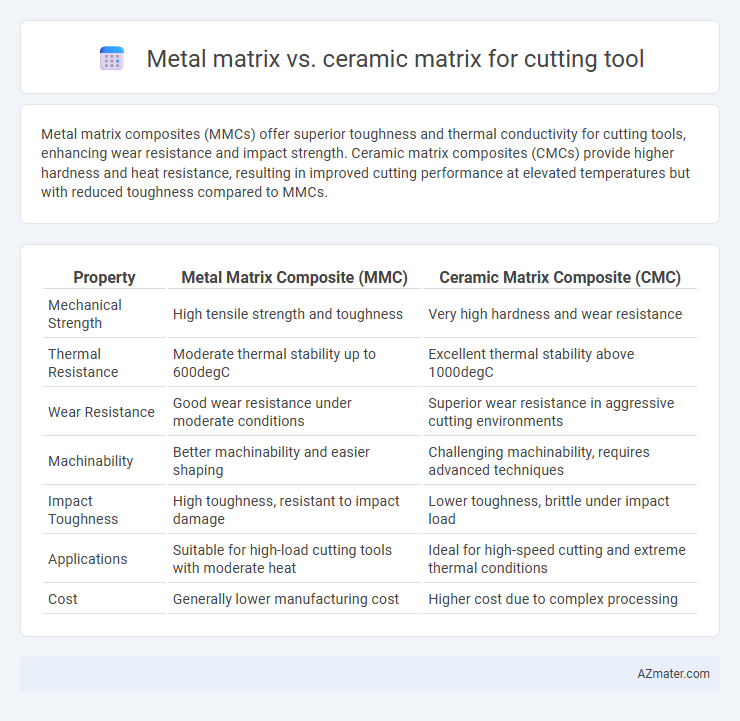Metal matrix composites (MMCs) offer superior toughness and thermal conductivity for cutting tools, enhancing wear resistance and impact strength. Ceramic matrix composites (CMCs) provide higher hardness and heat resistance, resulting in improved cutting performance at elevated temperatures but with reduced toughness compared to MMCs.
Table of Comparison
| Property | Metal Matrix Composite (MMC) | Ceramic Matrix Composite (CMC) |
|---|---|---|
| Mechanical Strength | High tensile strength and toughness | Very high hardness and wear resistance |
| Thermal Resistance | Moderate thermal stability up to 600degC | Excellent thermal stability above 1000degC |
| Wear Resistance | Good wear resistance under moderate conditions | Superior wear resistance in aggressive cutting environments |
| Machinability | Better machinability and easier shaping | Challenging machinability, requires advanced techniques |
| Impact Toughness | High toughness, resistant to impact damage | Lower toughness, brittle under impact load |
| Applications | Suitable for high-load cutting tools with moderate heat | Ideal for high-speed cutting and extreme thermal conditions |
| Cost | Generally lower manufacturing cost | Higher cost due to complex processing |
Introduction to Cutting Tool Materials
Cutting tool materials primarily consist of metal matrix composites (MMCs) and ceramic matrix composites (CMCs), each offering distinct advantages in machining applications. MMCs typically feature enhanced toughness and thermal conductivity, making them suitable for heavy-duty cutting with improved wear resistance. CMCs provide superior hardness and high-temperature stability, ideal for precision cutting and high-speed machining where tool longevity and heat resistance are critical factors.
Overview of Metal Matrix Composites
Metal matrix composites (MMCs) for cutting tools combine a metal alloy matrix, such as aluminum or titanium, with reinforcing materials like silicon carbide or alumina particles to enhance hardness, thermal conductivity, and wear resistance. These composites offer superior toughness and impact resistance compared to ceramic matrix composites (CMCs), making them suitable for high-speed, heavy-duty machining operations. MMC cutting tools also exhibit improved thermal management and longer tool life, optimizing machining efficiency and reducing downtime.
Overview of Ceramic Matrix Composites
Ceramic matrix composites (CMCs) are engineered materials combining ceramic fibers embedded within a ceramic matrix, offering exceptional hardness, high-temperature resistance, and superior wear properties essential for cutting tools. Unlike metal matrix composites, CMCs provide enhanced thermal stability and maintain cutting edge sharpness under extreme machining conditions, making them ideal for precision and high-speed cutting applications. Their lightweight nature and resistance to oxidation extend tool life and improve performance in abrasive environments.
Mechanical Properties Comparison
Metal matrix composites (MMCs) for cutting tools exhibit superior toughness and impact resistance compared to ceramic matrix composites (CMCs), which offer higher hardness and wear resistance. MMCs provide enhanced thermal conductivity and fracture toughness, making them suitable for operations requiring shock absorption and thermal management. CMCs excel in high-temperature stability and maintain cutting edge sharpness due to their lower thermal expansion and exceptional hardness levels.
Wear Resistance: Metal vs Ceramic Matrix
Ceramic matrix composites exhibit superior wear resistance compared to metal matrix composites due to their high hardness and thermal stability under extreme cutting conditions. Metal matrix composites, while offering better toughness and impact resistance, generally wear faster because of lower hardness and susceptibility to oxidation at elevated temperatures. Cutting tools with ceramic matrices maintain edge sharpness longer, making them ideal for high-speed machining of hard materials where wear resistance is critical.
Thermal Stability and Conductivity
Metal matrix composites for cutting tools offer superior thermal conductivity, enabling efficient heat dissipation during high-speed machining, which reduces tool wear. Ceramic matrix composites exhibit exceptional thermal stability, maintaining hardness and strength at elevated temperatures, thus enhancing tool life under extreme cutting conditions. The choice between metal and ceramic matrices depends on the balance between thermal conductivity for cooling and thermal stability for high-temperature performance in specific machining applications.
Machining Performance and Tool Life
Metal matrix composites (MMCs) in cutting tools offer superior toughness and thermal conductivity, enhancing machining performance by enabling higher cutting speeds and reducing tool wear in demanding operations. Ceramic matrix composites (CMCs) provide exceptional hardness and thermal stability, resulting in longer tool life during high-speed machining of hard materials but are more brittle and less impact-resistant than MMCs. Selecting between MMC and CMC cutting tools depends on balancing the need for toughness versus hardness, with MMCs favored for interrupted cutting and CMCs preferred for continuous, high-speed precision machining.
Cost and Manufacturing Considerations
Metal matrix composites for cutting tools offer lower manufacturing costs due to established processing techniques like casting and powder metallurgy, enabling easier scalability and repair. Ceramic matrix composites, while providing superior hardness and wear resistance, involve higher costs driven by complex sintering and machining processes, limiting widespread industrial adoption. The choice between metal and ceramic matrices hinges on balancing cost-efficiency with performance requirements in specific cutting applications.
Applications in Industry
Metal matrix composites dominate cutting tools in automotive and aerospace sectors due to their superior toughness and thermal conductivity, enabling high-speed machining of ferrous alloys. Ceramic matrix composites excel in high-precision machining and wear-resistant applications, particularly in electronics and turbine blade manufacturing, where hardness and thermal stability are critical. Industries prioritizing durability and heat resistance prefer ceramic matrices for cutting tools in machining hard materials like superalloys and composites.
Future Trends in Cutting Tool Materials
Future trends in cutting tool materials emphasize the development of hybrid metal matrix composites (MMCs) combining metals like aluminum or titanium with ceramic reinforcements to enhance thermal stability and wear resistance. Advancements in ceramic matrix composites (CMCs) focus on improving toughness and fracture resistance through nano-structured ceramics and advanced sintering techniques. Integration of additive manufacturing enables the design of complex tool geometries with optimized material distribution, driving performance improvements in both metal and ceramic matrix cutting tools.

Infographic: Metal matrix vs Ceramic matrix for Cutting tool
 azmater.com
azmater.com